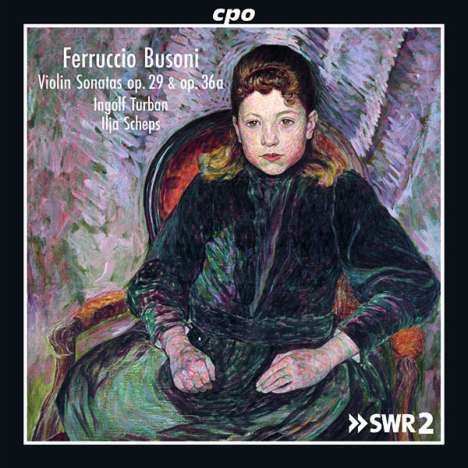Ferruccio Busoni: Sonaten für Violine & Klavier Nr.1 & 2 auf CD
Sonaten für Violine & Klavier Nr.1 & 2
Herkömmliche CD, die mit allen CD-Playern und Computerlaufwerken, aber auch mit den meisten SACD- oder Multiplayern abspielbar ist.
- Künstler:
- Ingolf Turban (Violine), Ilja Scheps (Klavier)
- Label:
- CPO
- Aufnahmejahr ca.:
- 2016
- Artikelnummer:
- 8977532
- UPC/EAN:
- 0761203521326
- Erscheinungstermin:
- 27.1.2020
Busonis progressive Violinsonaten
Es ist schon erstaunlich, dass ausgerechnet eine Violinsonate als bahnbrechendes Hauptwerk eines jungen Klaviervirtuosen gilt: Von Ferruccio Busonis beiden Violinsonaten, die 1889 und 1898 entstanden sind, ist die zweite op. 36a als absolutes Schlüsselwerk zu sehen. Dieses Werk erst definiere, nach Busonis eigener Aussage, seine kompositorische Eigenart. Dem ganzen Werk liegt ein Bach-Choral zugrunde, und es gipfelt in einem grandiosen Variationensatz über diesen Choral. Der enorme Zuspruch des Publikums und die Bewunderung für seine kompositorischen Transkriptionstechniken machten Busoni dann allerdings skeptisch, und er dachte, in konventionelle Bahnen damit geraten zu sein, was nicht der Fall war. Die erste Sonate op. 29 ist da sehr viel konventioneller. In seinen durchaus zeit- wie lebensgeschichtlichen Grenzen spricht das Werk heute nämlich ungewöhnlich deutlich zu uns, als Hommage an Brahms, der Busoni förderte oder gar als Anschluss an den pianistischen Matador der Zeit Anton Rubinstein, der selbst drei Violinsonaten publiziert hatte.
Product Information
Busoni’s Progressive Violin Sonatas
»For a long time no child prodigy has appealed to us so sympathetically as the little Ferruccio Busoni. Precisely because he has so little of the child prodigy about him, but instead a lot of the good musician, both as a pianist and as a budding composer.« This is what Eduard Hanslick, the famous Vienna music critic, had to say in 1876 about the ten-year-old Ferruccio Busoni. Around this time Busoni had already composed many works – mostly for clarinet with other instruments, and all these works were very much born of the spirit of his father, who played the clarinet. In his time Ferdinando Busoni was a famous virtuoso and created a sensation as a traveling artist with opera fantasies and virtuoso showpieces. Of his son’s two Violin Sonatas composed in 1889 and 1898, the op. 36a second sonata is to be regarded as an absolute key work. According to Busoni’s own testimony, it first delineated his unique character as a composer. The entire work is based on a Bach chorale, and it culminates in a magnificent variation movement on the same. However, his enormous public appeal and the admiration for his transcription technique made Busoni skeptical, and he thought that he had strayed onto conventional paths – which was not the case. The op. 29 first sonata is very much more conventional. Within its limits, very much in keeping with its composer’s life and times, the work today speaks unusually clearly to us, as an homage to Brahms, who supported Busoni, or as a link to the great pianist of those times, Anton Rubinstein, who himself published three violin sonatas.
Rezensionen
FonoForum 06/2020: »Die Sonate Nr. 1 op.29 verdeutlicht die musikalischen Schwierigkeiten, welche diese Musik aufwirft: Sie hebt wie ein Violinkonzert an, um dann einen kammermusikalischen Duktus anzunehmen, der nur schwer mit der - auch dem Klavier abverlangten - spieltechnisch-konzertanten Virtuosität in Übereinstimmung zu bringen ist. Aber gerade in diesem Changieren liegt der unvergleichliche Reiz dieser Musik. Das wird in der zweiten Violinsonate op,.36a womöglich gesteigert: Diese Sonate - sie ist das erste Werk, das Busoni auch später voll gelten ließ - bietet sogar Variationen über einen Bach-Choral (wer dachte da nicht an Bergs Violinkonzert!), die sie zu einem gänzlich singulären, faszinierenden Werk machen. Turban und Scheps interpretieren das alles mit bestechender musikalischer Intelligenz; sie lassen sich mitunter geradezu hemmungslos auf diese Musik ein und bieten schroff-differenzierende Lesarten in allen Ausdrucksbereichen.«Disk 1 von 1 (CD)
Sonate für Violine und Klavier Nr. 1 e-moll op. 29
-
1 1. Adagio
-
2 2. Allegro giocoso
-
3 3. Adagio
Sonate für Violine und Klavier Nr. 2 e-moll op. 36a
-
4 1. Adagio
-
5 2. Allegro giocoso
-
6 3. Adagio
-
7 4. Allegro giocoso
-
8 5. Adagio
-
9 6. Allegro giocoso
-
10 7. Adagio
-
11 8. Allegro giocoso
-
12 9. Allegro giocoso
-
13 10. Adagio
-
14 11. Allegro giocoso
Mehr von Ferruccio Busoni














